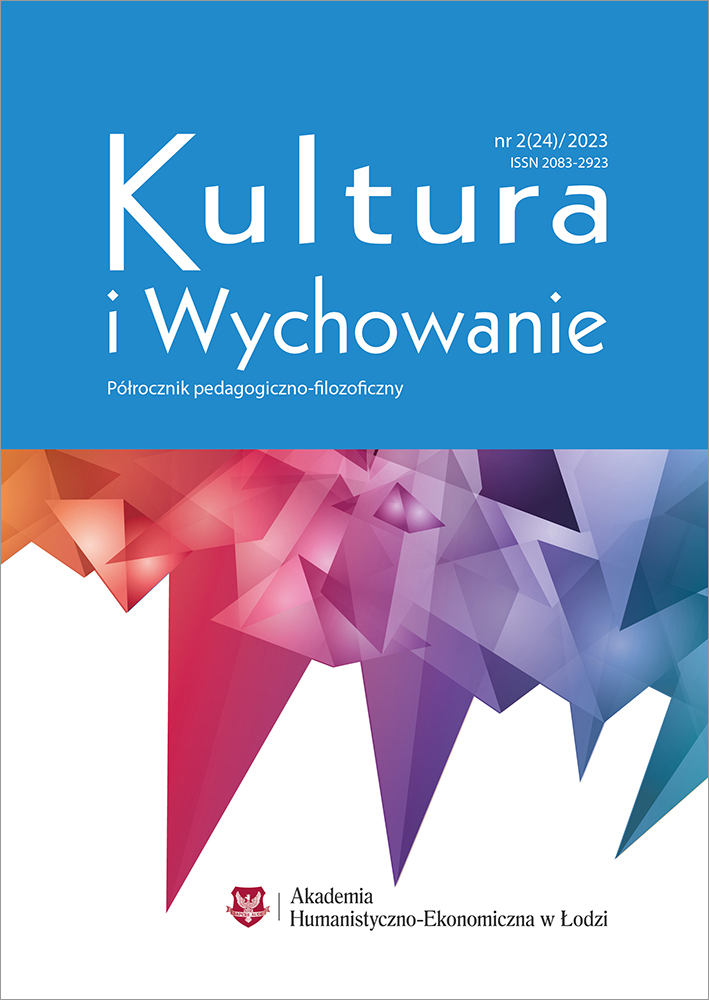The importance of artistic expression in expressing emotions of a child on the autism spectrum - a case study
DOI:
https://doi.org/10.25312/2083-2923.24_02lsKeywords:
autism spectrum disorder, art therapy, fine arts, drawing, emotions, disordersAbstract
For many years, therapeutic methods have been developed to improve the quality of life for people on the autism spectrum. One of the most modern therapeutic forms is art therapy. The creative process stimulates both cerebral hemispheres at the same time. This results in the emotional and cognitive development of the child and this, in turn, improves the child’s social development. In addition, an autistic child who has difficulty controlling and expressing his or her emotions through drawing, painting or sculpting has the opportunity to learn how to deal with emotional tension. When analyzing the artistic creations of autistic children, one can not only get an aesthetic impression, but also notice their hidden content. They represent an individual story of emotions, experiences and deeply hidden anxieties. The drawings are characterized by their simplicity, schematic and minimalist form. By knowing the meanings of the expressions used, we can try to get to know the child’s personality traits, character, passions and history. Autism spectrum disorder hinders drawing development considerably, but does not rule it out completely. The main aim of the article, ‘The importance of artistic expression in expressing the emotions of a child on the autism spectrum – a case study’, is to draw conclusions from the analysis of the drawing works of an autistic child in the context of the child’s varied emotions. The author of the article, drawing on the literature on the subject and her own experiences and interests, describes the world of emotions of a child with autism spectrum hidden in the drawings.
Downloads
References
Głowacka E., Artediagnoza. Psychologiczna specyfika twórczości plastycznej dzieci neurotycznych, Wydawnictwo Uniwersytetu Jagiellońskiego, Kraków 2006.
Hornowski B., Badania nad rozwojem psychicznym dzieci i młodzieży na podstawie rysunku postaci ludzkiej, Zakład Narodowy im. Ossolińskich, Wrocław 1982.
Konieczna E.J., Arteterapia w teorii i praktyce, Oficyna Wydawnicza „Impuls”, Kraków 2007.
Kulczycki M., Psychologiczne problemy człowieka chorego: z zagadnień współpracy pracownika służby zdrowia z pacjentem, Zakład Narodowy im. Ossolińskich, Wrocław 1971.
Łobocki M., Metody i techniki badań pedagogicznych, Oficyna Wydawnicza „Impuls”, Kraków 2011.
Łobocki M., Wprowadzenie do metodologii badań pedagogicznych, Oficyna Wydawnicza „Impuls”, Kraków 2004.
Marek E., Arteterapia jako metoda wspomagająca pracę wychowawczą, [w:] M. Knapik, A. Sacher (red.), Sztuka w edukacji i terapii, Oficyna Wydawnicza „Impuls”, Kraków 2004.
Oster G.D., Gould P., Rysunek w psychoterapii, Gdańskie Wydawnictwo Psychologiczne, Gdańsk 2004.
Pomorska K., Rozwój regulacji emocji o typowym i zaburzonym rozwoju, 2019, https://terapiaspecjalna.pl/artykul/rozwoj-regulacji-emocji-o-typowym-i-zaburzonym-rozwoju [dostęp: 28.01.2023].
Rudowski T., Edukacja i terapia przez sztukę. Arteterapia w świetle teorii doznań transakcyjnych, Eneteia Wydawnictwo Psychologii i Kultury, Warszawa 2013.
Stańko M., Arteterapia – mechanizmy działania z perspektywy neuropsychologii, „Psychoterapia” 2009, nr 2(149), s. 29–35.
Szuman S., Sztuka dziecka, Wydawnictwa Szkolne i Pedagogiczne, Warszawa 1990.
Westling C.S., On Neuroscience and Art Therapy – Clinical Meeting, https://arttherapycentre.com/blog/neuroscience-art-therapy-clinical-meeting/ [dostęp: 28.01.2023].
Downloads
Published
Issue
Section
License
Copyright (c) 2024 Akademia Humanistyczno-Ekonomiczna w Łodzi

This work is licensed under a Creative Commons Attribution-ShareAlike 4.0 International License.

